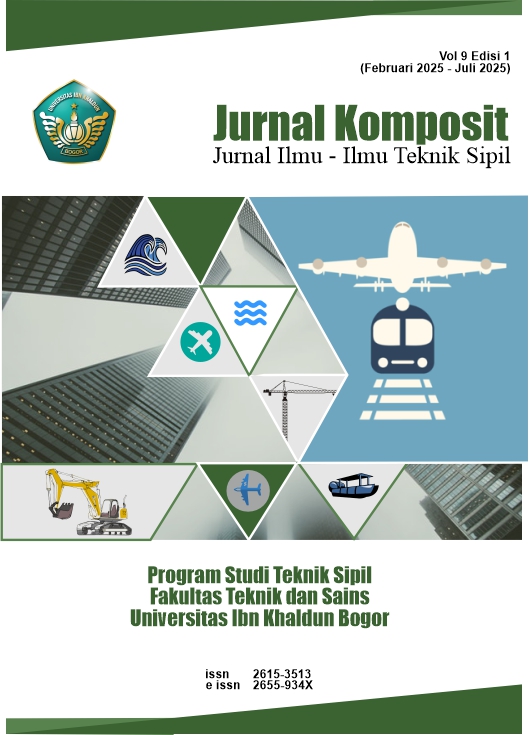Kajian Kebutuhan Irigasi Sawah di Lapangan Daerah Irigasi Cihea Kabupaten Cianjur
DOI:
https://doi.org/10.32832/komposit.v9i1.17264Keywords:
measurement, irrigation, rice field, water requirementAbstract
Indonesia is known as an agricultural country because most of its people cultivate rice in rice fields. BPS through the area survey framework (KSA) stated that the total harvest area in 2022 was 10.45 million hectares. This large area is very likely to cause inefficient water use in rice cultivation considering that most of the cultivation is carried out by inundation. Measurement of irrigation water needs in rice fields has been carried out mostly in the analysis stage, no detailed measurements have been found in evaluating irrigation water needs in rice fields. Evaluating the need for irrigation water in rice fields can easily be done with a water balance approach that considers all aspects of both incoming and outgoing water. This study aims to examine the components of irrigation water needs in the land preparation period. The study was conducted on rice plots equipped with several measuring instruments. Measuring water discharge in and out using CTF, weather data using AWS, and percolation measurements in the field. Measurement of water demand in rice fields on the plot resulted in a total inflow value of 195.38 mm and rainfall of 40.40mm. The total value of evapotranspiration occurred was 104.11 mm, the percolation value was 54.00 mm and the discharge out value was 29.59 mm, so the water loss was 48.08 mm (24.61%)
References
Anggraeni, I. D. S., & Kalsim, D. K. (2013). Perbandingan Perhitungan Kebutuhan Irigasi Padi Metoda KP-01 dengan Cropwat-8.0. Jurnal Irigasi, 8(1), 15–23. https://doi.org/10.31028/JI.V8.I1.15-23
Arif, C., Purwanto, M. Y. J., Saptomo, S. K., Sutoyo, Heryansyah, A., & Sofiyuddin, H. A. (2023). Evaluasi Penentuan Kebutuhan Air Pengolahan Tanah dengan Persamaan Van De Goor & Zijlstra pada Budidaya Padi Sawah. Jurnal Teknik Sumber Daya Air, 2023(1), 67–76. https://doi.org/10.56860/JTSDA.V3I1.45
Arif, C., Setiawan, B. I., Saputra, S. F. D., & Mizoguchi, M. (2019). Analisis Neraca Air pada Pengelolaan Air dalam System of Rice Intensification-Organik (SRI-organik) di Jawa Barat, Indonesia. Jurnal Irigasi, 14(1), 17–24. https://doi.org/10.31028/JI.V14.I1.17-24
Badan Pusat Statistik. (2023). Luas Panen dan Produksi Padi di Indonesia 2022: Hasil Kegiatan Pendataan Statistik Pertanian Tanaman Pangan Terintegrasi dengan Metode Kerangka Sampel Area. In Katalog: 5203031. https://www.bps.go.id/id/publication/2023/08/03/a78164ccd3ad09bdc88e70a2/luas-panen-dan-produksi-padi-di-indonesia-2022.html
Hargreaves, G. H. (1975). Moisture Availability and Crop Production. Transactions of the ASAE, 18(5), 980–0984. https://doi.org/10.13031/2013.36722
Mdemu, M. V., Francis, T., Mdemu, M. V., & Francis, T. (2013). Productivity of Water in Large Rice (Paddy) Irrigation Schemes in the Upper Catchment of the Great Ruaha River Basin, Tanzania. Water Resources Planning, Development and Management. https://doi.org/10.5772/52471
Priyonugroho, A. (2014). Analisis Kebutuhan Air Irigasi (Studi Kasus Pada Daerah Irigasi Sungai Air Keban Daerah Kabupaten Empat Lawang). Jurnal Teknik Sipil Dan Lingkungan, 2(3), 457–470. https://ejournal.unsri.ac.id/index.php/jtsl/article/view/1302
Razavipour, T., & Farrokh, A. R. (2014). Measurement of Vertical Water Percolation Through Different Soil Textures of Paddy Field During Rice Growth Season. International Journal of Advanced Biological and Biomedical Research, 2(5), 1379–1388. https://www.ijabbr.com/article_7338.html
Saptomo, S. K., Purwanto, M. Y. J., Sutoyo, S., Arif, C., Heryansyah, A., Samsuar, S., Rusianto, R., & Sofiyuddin, H. A. (2022). Pengembangan Sistem Pengukuran dan Pengamatan Kebutuhan Air Irigasi Berbasis Jaringan Internet. Pertemuan Ilmiah Tahunan PIT Ke 39 HATHI, 2541–2554. https://hathi.id/pit39-hathi/
Sosrodarsono, S. (2006). Hidrologi untuk Pengairan. Pradnya Paramita.
Downloads
Published
How to Cite
Issue
Section
License
Copyright (c) 2025 Jurnal Komposit: Jurnal Ilmu-ilmu Teknik Sipil

This work is licensed under a Creative Commons Attribution-NonCommercial-ShareAlike 4.0 International License.
Authors who publish with this journal agree to the following terms (Penulis yang mengajukan publikasi artikel telah menyetujui hal berikut):
- Through this publication, the author agree to submit the copyright of article writing to Jurnal Komposit: Jurnal Ilmu-ilmu Teknik Sipil. This copyright submission takes the form of, but is not limited to: reproduction of the article and parts therein, including photographic reproductions; distribution of articles through printed and electronic documents; and translation of articles(Bahwa melalui publikasi ini, hak cipta penulisan artikel diserahkan kepada Jurnal Komposit: Jurnal Ilmu-ilmu Teknik Sipil. Penyerahan hak cipta ini berupa, namun tidak terbatas pada: perbanyakan artikel dan bagian di dalamnya, termasuk reproduksi fotografi; penyebarluasan artikel melalui dokumen cetak dan elektronik; serta penterjemahan artikel).
- The authors agree to the terms of the Copyright Notice, according to Creative Commons Attribution-NonCommercial-ShareAlike 4.0 International License., which will apply to this article if and when it is published by Jurnal Komposit: Jurnal Ilmu-ilmu Teknik Sipil. (Para penulis setuju dengan ketentuan Pemberitahuan Hak Cipta, sesuai dengan Lisensi Internasional Creative Commons Attribution-NonCommercial-ShareAlike 4.0., yang akan berlaku untuk artikel ini jika dan ketika diterbitkan oleh Jurnal Komposit: Jurnal Ilmu-ilmu Teknik Sipil).

This work is licensed under a Creative Commons Attribution-NonCommercial-ShareAlike 4.0 International License.



.png)










